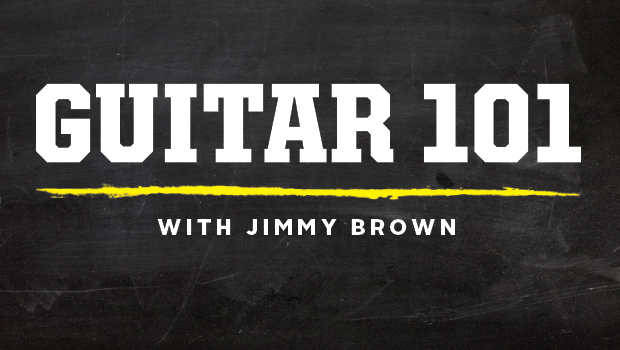Guitar 101: Mastering Rhythm and Syncopation, Part 2 — 16th Notes, Rests and Dotted Rhythms

In Part 1, we learned how to count and play basic rhythms in 4/4 time and subdivide beats into eighth notes by counting "one and, two and, three and, four and, one and, two and, three and, four and," etc.
We also learned how to create syncopation by using ties to combine rhythmic values (durations) in order to emphasize the "weak" parts of the measure-such as the eighth-note upbeats (the "and" counts). In this lesson we're going to expand our rhythmic vocabulary and learn how to count and read 16th notes, rests and dotted rhythms. We're also going to learn a very useful practicing technique that can help you sight-read transcriptions more easily and accurately.
A measure of 4/4 can be subdivided into sixteen 16th notes, as illustrated in FIGURE 1. Notice that the 16th notes are grouped in fours within each beat by two horizontal beams.
Counting "one ee and uh, two ee and uh, three ee and uh, four ee and uh, one ee and uh, two ee and uh, three ee and uh, four ee and uh," etc. enables us to keep track of each individual 16th note while maintaining a steady pulse. (You may find it helpful to visualize a measure of 4/4 time as being an inch on a ruler held horizontally, with each quarter-inch mark representing a quarter-note beat, and each 16th-inch mark representing a 16th note.)
Music is a combination of sound and silence. Every rhythmic value-whole note, half note, quarter note, eighth note, etc.-has a corresponding rest that represents a moment of silence of the same duration. FIGURES 2a-c include all the rhythmic values we've covered thus far, plus their equivalent rests. Notice that when rests are used, eighth notes and 16ths sometimes stand alone, in which case they're indicated by flags instead of beams, a single 16th note having two flags. When playing through these examples, be sure to silence your strings during the rests and to count and tap your foot as indicated.
A dot placed to the right of a notehead or tab number means that its rhythmic value is increased by one half (multiplied by 1.5). Thus, a dotted half note is held for three beats; a dotted quarter note is held for one and one half beats; and a dotted eighth note is held for three fourths of one beat (see FIGURE 3).
When the rules of music notation allow, syncopated rhythms can be indicated with dotted notes instead of ties, as demonstrated in FIGURE 4. As you can see, this form of notation is more economical than using ties all the time because there are fewer items on the page to read. As this example also shows, rests can be dotted as well.
Get The Pick Newsletter
All the latest guitar news, interviews, lessons, reviews, deals and more, direct to your inbox!
Subdivide and Conquer
When sight-reading any transcription for the first time, it's always a good idea to first focus on reading and trying to master only the rhythms before picking up your guitar and attempting to deal with everything all at once (rhythms, different notes, fingerings, repeat signs and whatnot.). To do this, simply clap the rhythms of the notes or chords (or tap them on your knee) while counting and tapping your foot on each beat, subdividing your count only when necessary.
Doing this rhythm-only sight-reading drill will help make it easier to concentrate on counting and hitting the rhythms correctly because you're not simultaneously processing and reacting to all of the other information presented. (It will also give you extra practice reading and counting rhythms, which will help improve your skills.)
Once you've gotten the rhythm of the notes in your mind's ear, pick up your guitar and attempt to play the song or lick. You'll find that it will be much easier to sight-read the music after having first done the rhythm-only drill because you're already familiar with the timing and phrasing of the notes. (I've had much success using this approach with my students, and it's something I always do myself when reading a piece of music for the first time.)
Keep in mind that in any measure of metered music, every part of every beat must be accounted for by some kind of note or rest. For example, in a measure of 4/4 time, the total value of all the notes and rests must add up to four complete beats. This may seem like a trivial theoretical point, but it's a useful axiom to remember because it can help you figure out, by process of elimination, the correct timing and placement of a complex or unfamiliar rhythmic figure: First, subtract the rhythms you do know from the beginning and end of the measure, then calculate how many beats or partial beats are unaccounted for. This will enable you to isolate the unknown rhythms and help you determine where they begin and end relative to the underlying pulse. If you're still unsure of the rhythm, listen to a recording of the song, if one is available, or ask a music teacher or drummer to count it out loud and play it for you.
Over the past 30 years, Jimmy Brown has built a reputation as one of the world's finest music educators, through his work as a transcriber and Senior Music Editor for Guitar World magazine and Lessons Editor for its sister publication, Guitar Player. In addition to these roles, Jimmy is also a busy working musician, performing regularly in the greater New York City area. Jimmy earned a Bachelor of Music degree in Jazz Studies and Performance and Music Management from William Paterson University in 1989. He is also an experienced private guitar teacher and an accomplished writer.










